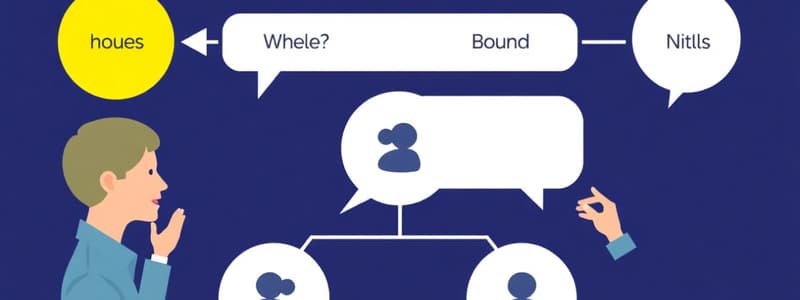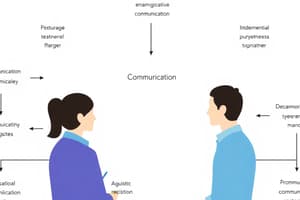Podcast
Questions and Answers
What type of language skills are acquired systematically and consciously?
What type of language skills are acquired systematically and consciously?
- Formal micro language skills (correct)
- Receptive language skills
- Informal language skills
- Macro language skills
Which of the following is not considered a primary skill?
Which of the following is not considered a primary skill?
- Speaking
- Writing
- Listening
- Reading (correct)
Which classification of language skills includes both listening and writing?
Which classification of language skills includes both listening and writing?
- Formal skills
- Primary productive skills
- Receptive skills (correct)
- Expressive skills
How are language skills categorized based on production versus reception?
How are language skills categorized based on production versus reception?
Which of the following represents a secondary language skill?
Which of the following represents a secondary language skill?
What characterizes small group communication?
What characterizes small group communication?
Which method is NOT typically used in public communication?
Which method is NOT typically used in public communication?
Which of the following accurately describes mass communication?
Which of the following accurately describes mass communication?
What is the first step in the communication process?
What is the first step in the communication process?
In verbal communication, which of the following is primarily used?
In verbal communication, which of the following is primarily used?
What element of communication is essential for confirming understanding?
What element of communication is essential for confirming understanding?
Which mode of language acquisition is characterized by structured teaching?
Which mode of language acquisition is characterized by structured teaching?
What makes human communication unique compared to other animals?
What makes human communication unique compared to other animals?
What is the primary purpose of communication as defined in the content?
What is the primary purpose of communication as defined in the content?
Which of the following is NOT a mode of communication mentioned in the content?
Which of the following is NOT a mode of communication mentioned in the content?
Intra-personal communication is primarily characterized by which of the following?
Intra-personal communication is primarily characterized by which of the following?
Interpersonal communication typically involves which key component?
Interpersonal communication typically involves which key component?
What happens when individuals have certain medical challenges according to the content?
What happens when individuals have certain medical challenges according to the content?
Effective communication requires the ability to convey information in a way that is:
Effective communication requires the ability to convey information in a way that is:
How is interpersonal communication different from intra-personal communication?
How is interpersonal communication different from intra-personal communication?
Which of the following best defines communication as discussed in the content?
Which of the following best defines communication as discussed in the content?
What is the primary mode of language acquisition for children in the Nigerian context?
What is the primary mode of language acquisition for children in the Nigerian context?
Which of the following is NOT classified as a macro language skill?
Which of the following is NOT classified as a macro language skill?
What are primary macro language skills?
What are primary macro language skills?
Secondary macro language skills consist of which of the following?
Secondary macro language skills consist of which of the following?
Which of the following accurately describes informal micro language skills?
Which of the following accurately describes informal micro language skills?
Which statement best defines macro language skills?
Which statement best defines macro language skills?
What distinguishes primary macro language skills from secondary macro language skills?
What distinguishes primary macro language skills from secondary macro language skills?
What type of skills do phonemes and letters represent in language acquisition?
What type of skills do phonemes and letters represent in language acquisition?
Flashcards
What is communication?
What is communication?
The act of sharing or exchanging information, ideas, or feelings between individuals or groups.
The Communication Process
The Communication Process
The process of communication involves a sender, a message, a channel, a receiver, and feedback.
Verbal Communication
Verbal Communication
Verbal communication involves using spoken words to convey information. It includes conversations, presentations, and lectures.
Non-verbal Communication
Non-verbal Communication
Signup and view all the flashcards
Language Skills
Language Skills
Signup and view all the flashcards
Intra-personal Communication
Intra-personal Communication
Signup and view all the flashcards
Interpersonal Communication
Interpersonal Communication
Signup and view all the flashcards
Signing Communication
Signing Communication
Signup and view all the flashcards
Small Group Communication
Small Group Communication
Signup and view all the flashcards
Public Communication
Public Communication
Signup and view all the flashcards
Mass Communication
Mass Communication
Signup and view all the flashcards
Communication Process
Communication Process
Signup and view all the flashcards
Elements of Communication
Elements of Communication
Signup and view all the flashcards
What is Language?
What is Language?
Signup and view all the flashcards
Formal Language Skills
Formal Language Skills
Signup and view all the flashcards
Receptive Language Skills
Receptive Language Skills
Signup and view all the flashcards
Expressive Language Skills
Expressive Language Skills
Signup and view all the flashcards
Informal Language Skills
Informal Language Skills
Signup and view all the flashcards
Productive Language Skills
Productive Language Skills
Signup and view all the flashcards
Formal language acquisition
Formal language acquisition
Signup and view all the flashcards
Informal language acquisition
Informal language acquisition
Signup and view all the flashcards
Macro language skills
Macro language skills
Signup and view all the flashcards
Primary macro language skills
Primary macro language skills
Signup and view all the flashcards
Secondary macro language skills
Secondary macro language skills
Signup and view all the flashcards
Micro language skills
Micro language skills
Signup and view all the flashcards
Informal micro language skills
Informal micro language skills
Signup and view all the flashcards
Study Notes
Introduction to Communication
- Communication is the act of conveying or sharing ideas
- Humans are designed to relate to each other, needing information, knowledge, encouragement and more
- Communication involves expressing internal thoughts and feelings in a way that others understand
- This process requires a sender and receiver
Types of Communication
- Intra-personal: Communication with oneself (soliloquy)
- Interpersonal: Communication between two people or a small group
- Public: Communication to a general population or a specific group
- Mass: Dissemination of information to a large, anonymous group (e.g., through media)
The Communication Process
- Involves a sender (encoder) and a receiver (decoder)
- Communication is incomplete without feedback from the receiver
- Feedback confirms understanding of the sender's intent
- Key elements include the message, encoding activity, channel, and feedback
Elements of Communication
- Communication has human and process elements involved
- Sender, receiver, message, encoding methods, channels, feedback
Language as a Tool for Effective Communication
- Language is a crucial tool for human communication
- Composed of structured words in speech, writing, or gestures
Modes of Communication
- Spoken: Using sounds/voice
- Written: Using letters/symbols
- Signing: Using hand signals in exceptional cases like deafness or dumbness
Modes of Language Acquisition
- Formal: Learning language in a structured environment like school
- Informal: Learning language through interactions with the immediate environment
Language Skills
-
Macro Skills:
- Primary (Informal): Listening/Speaking (naturally acquired)
- Secondary (Formal): Reading/Writing (learnt via instruction).
-
Micro Skills:
- Informal: Pronunciation, vocabulary (unconscious, non-systematic)
- Formal: Spelling, grammar, meaning (systematic, conscious)
-
Receptive skills involve receiving information (Listening/Reading)
-
Expressive skills involve producing information (Speaking/Writing)
Studying That Suits You
Use AI to generate personalized quizzes and flashcards to suit your learning preferences.




